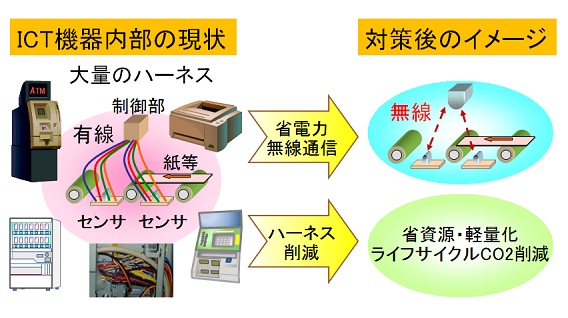Flexible and sharing use of frequencies in wireless systems
Industry science and medical (ISM) bands including the 2.4 GHz band, are shared by various wireless systems such as wireless local area network (LAN) (IEEE 802.11a/b/g/n), codeless phone (WDCT), and wireless headset using Bluetooth or Zigbee, and other equipment that emits radio wave such as microwave oven.
Such small-sized wireless system and equipment that uses the ISM bands without license will be further widely deployed in accordance to future growth of networked society, and it leads to significant increase of demand on wireless communications and radio resources. In general, these wireless systems using the ISM bands individually select their operational frequency (channel).
When there is too much wireless equipment, unused radio resources are widely scattered and distributed over the time and frequency (and spatial) domains.
This study develops a communication technology called “dynamic spectrum access (DSA)” that realizes both efficient use of radio resources and wideband transmission by finding and combining such scattered unused radio resources for wireless transmission.
There are two key technologies to realize efficient DSA.
Band-limited divided-spectrum single carrier transmission
This transmission scheme divides the spectrum of a single-carrier signal into multiple sub-spectra by band-limiting filters and convert their frequencies so as to fit the spectra to unused radio resources (channels). This transmission scheme can mitigate power leakage into adjacent channels and peak-to-average power ratio (PAPR) comparing to orthogonal frequency division multiplexing (OFDM).
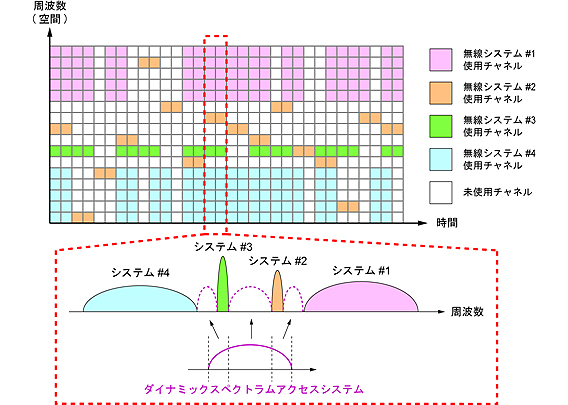
Common channel scheme using CSMA/CA and frequency hopping
For robust exchange of control message, we have proposed a MAC protocol employing a common control channel with channel (frequency) hopping in order to avoid interference from/to other wireless systems. The hopping pattern is designed so that adjacent cells use near radio (frequency) channels each other for easy information exchange and avoiding collisions among these cells. Furthermore, user data and control information ate multiplex in the frequency domain so as to reduce control overhead.
Efficient multi-layered wireless transmission using spatial domain
Frequency channel is getting congested according to the increase of users and the amount of user traffic. However, the available frequency channels are limited. So, we have developed space-division multiplex (SDM) technology that overlays multiple wireless transmissions with the aid of antenna directivity that can mitigate interference in the spatial domain, mainly applicable to small-sized wireless equipment in the ISM bands. Major research topics are as follows.
- Design of small-sized and high-performance antenna element;
- Hybrid beamforming methods applicable with small computational complexity;
- Cross-layer (PHY/MAC) design for SDM;
- Development of channel sounding equipment for the study of radio propagation.
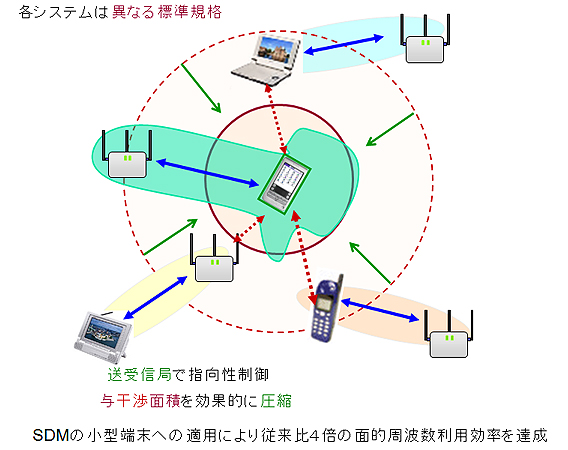
“Research and development of M2M-type dynamic wireless communication network construction technology”, “Research and development of high-density linear cell MIMO system using leaky coaxial cable”, etc.
Research of efficient wireless networking for dense-user-situations
We develop efficient wireless networking technologies for the situations that there are many users and/or coexisting wireless networks. One is a networking technology for machine-to-machine (M2M) / Internet-of -Things (IoT) communications in order to guarantee a certain level of quality-of-service (QoE) for many users and/or radio terminals. The developed technology includes smart radio-environment sensing, and channel access with the aid of QoE estimation.
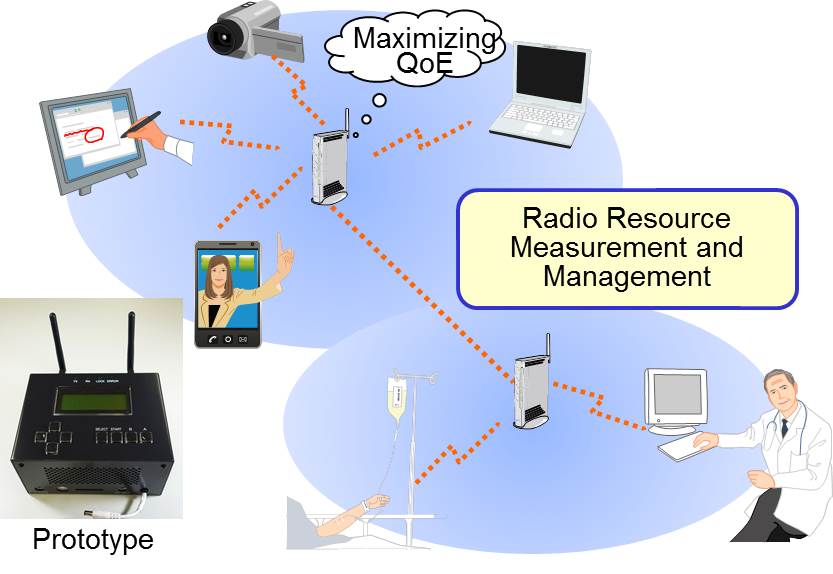
Linear cell wireless access technology that realizes high-speed and stable communication using leaky coaxial cable
Another one is a multi-input multi-output (MIMO) transmission technology using leakage coaxial (LCX) for high-efficient wireless transmission in linear cells that cover a bullet train (Sinkansen), tunnel and underground mall, etc. The developed technology includes MIMO channel generation using a LCX cable, signal processing for MIMO using a LCX cable, and precise estimation of user location. The developed technology will provide efficient short-range wireless communications in high-dense user situations.
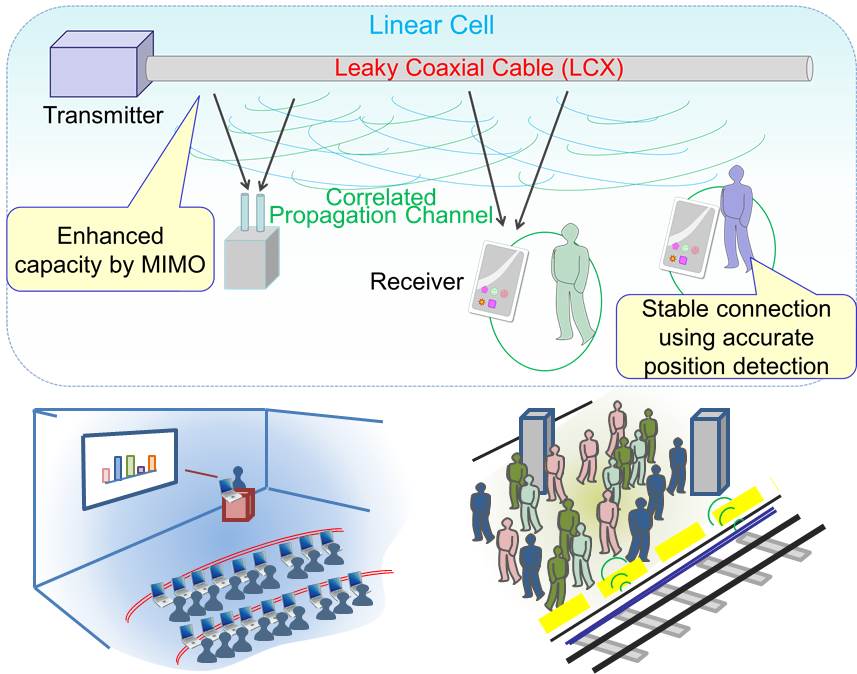
Investigation of wireless system usage and consultancy
With the increasing use of unlicensed bands, the way to share this frequency band among multiple wireless systems has become a very important issue.
We investigate wireless system usage and conduct consultations based on wireless system knowledge, simulation and measurement know-how.
The demand for the 2.4 GHz ISM band, which is a typical example, is increasing due to the spread of hot spot services, smartphones, tablet PCs, mobile routers, etc. Investigations are being conducted to better utilize this frequency band. First, we measure the spectrogram of the radio signal simultaneously from the frequency axis and the time axis. In addition, traffic between wireless devices is observed and a comprehensive visualization of radio wave usage is provided. From these results, we investigate frequency utilization efficiency, interference between wireless systems, and user throughput.
We understand the current situation and provide advice and suggestions for improving communication quality in environments where multiple wireless LANs, Bluetooth, cordless phones, and microwave ovens with different installers and users coexist.
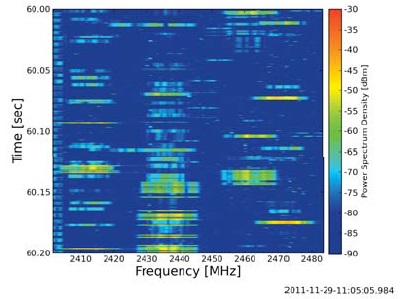
Commissioned project apart from the above
・Strategic Information and Communications R&D Promotion Programme (SCOPE)
“Research and development of reception point moving type equalization technology for improving wireless communication data rate at high speed mobile”
“Research and development of simultaneous observation technology by multiple unmanned aerial vehicles using active 3D communication area control”
Nonlinear MIMO technology
Nonlinear MIMO technology:Pursuit of technology to spatially multiplex signals
With the spread of smartphones, traffic demand for mobile phones has exploded. We are studying nonlinear multi-user MIMO technology to further improve spectrum utilization efficiency.
Multi-user MIMO technology is a spatial multiplexing technology that uses the characteristics of the radio wave propagation path from a base station to multiple mobile terminals is different. Multi-user MIMO technology using linear operation has already been put to practical use. However, in small cells such as picocells and femtocells, the radio wave propagation paths are similar because the line of sight from the base station to the mobile terminal becomes dominant. This makes it difficult to separate multiplexed signals.
Therefore, in this research, we will establish a high-performance multi-user MIMO technology using non-linear operation, and realize an improvement in frequency utilization efficiency even in small cells.
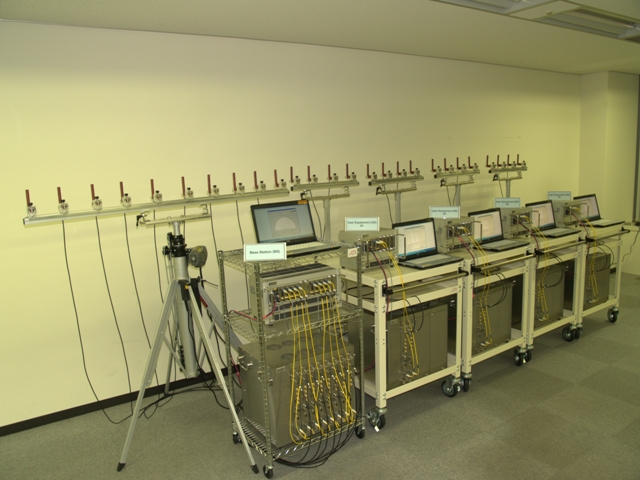
Ultra-high-speed gigabit-class wireless LAN
As shown in the image diagram, the ultra-high-speed gigabit wireless LAN system can transmit and receive at a maximum transmission speed of 3 Gbps in indoor point-to-multi points environments using millimeter waves. In this research, we developed 60GHz band elemental technology, constructed an ultra-high-speed wireless LAN system, and conducted a verification test. This is the first demonstration test of 3 Gbps wireless LAN system using millimeter waves in Japan.
The following technologies have been newly established to enable the above ultra-high-speed communication.
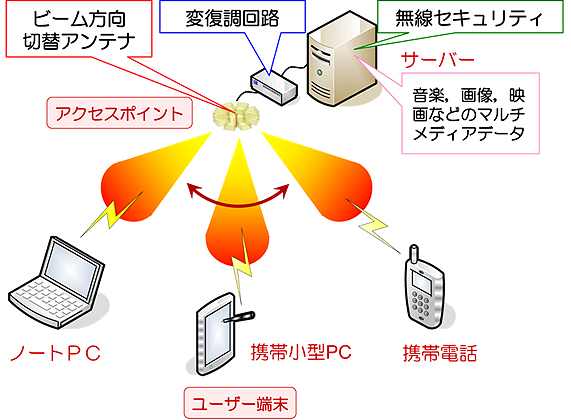
New technology that enables ultra-high-speed communication
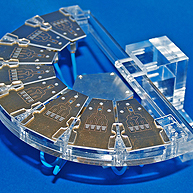
Antenna technology
We have developed high gain and wideband antenna that can switch the beam direction so that high-speed communication can be performed anywhere indoors.

Wireless security technology
We have developed a unique and secure key generation and sharing technology that cannot be decrypted by high-speed computers, and demonstrated that high security can be obtained.
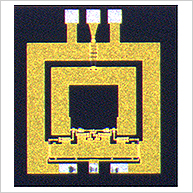
Modulation/demodulation circuit technology
We prototyped an IC using a modulation method called FSK(Frequency shift keying), and succeeded in a transmission experiment of up to 5m in the 60GHz band using this IC.
This technology is expected to be able to handle larger amounts of digital content on indoor private wireless LANs and outdoor public wireless LANs.
Reduction of wires in ICT equipment by wireless communication and contribution to low CO2 emissions
In order to realize a wireless harness, we are conducting R&D from three viewpoints: “wireless communication of the same performance with wired”, “CO2 reduction”, and “installation in equipment”.
In order to ensure the same performance as that of wired communication, instead of “Best Effort”, which sends as much information as possible, “Guarantee”, a highly reliable wireless communication technology that transmits information reliably in a fixed time, is required. For this purpose, we conducted radio wave propagation measurement using the assumed ICT equipment housing and simulated the propagation environment analysis inside the equipment. Currently, we are working on the optimal design of access control methods and transmission / reception circuits to efficiently collect a large number of sensor information in a narrow space environment within the equipment.
Next, from the viewpoint of power saving and CO2 reduction, we are studying thorough operation mode selection and ultra-low power consumption for each wireless module.
We are working on the development of ultra-small antennas and stamp-sized wireless modules for installation in narrow spaces within ICT equipment.
An approach from three perspectives
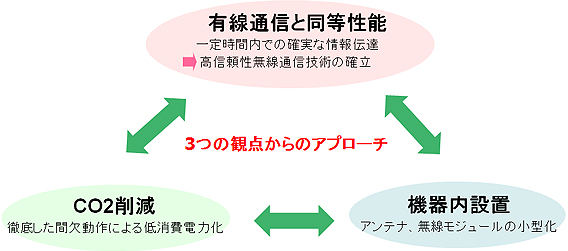
Current situation inside ICT equipment
